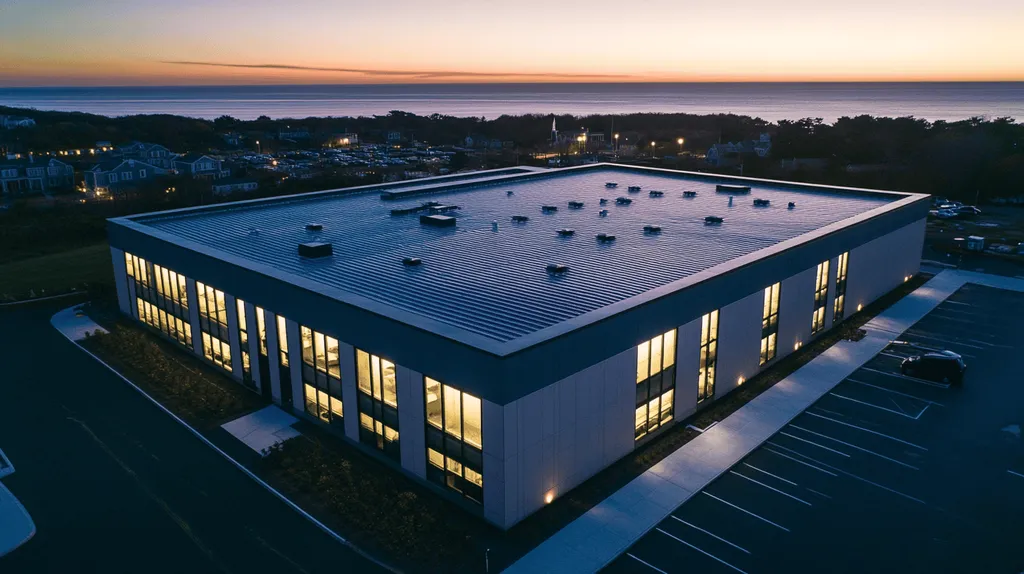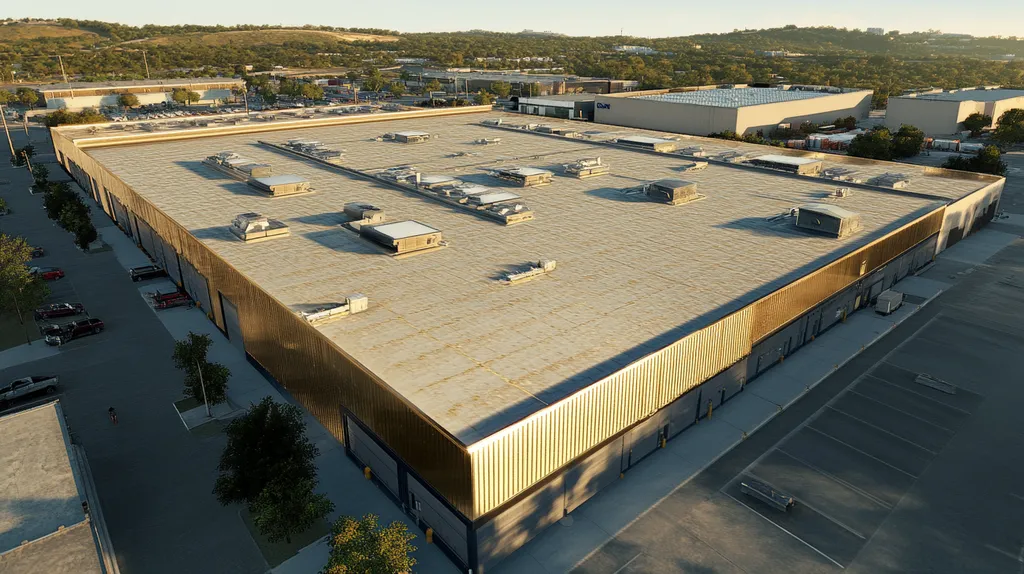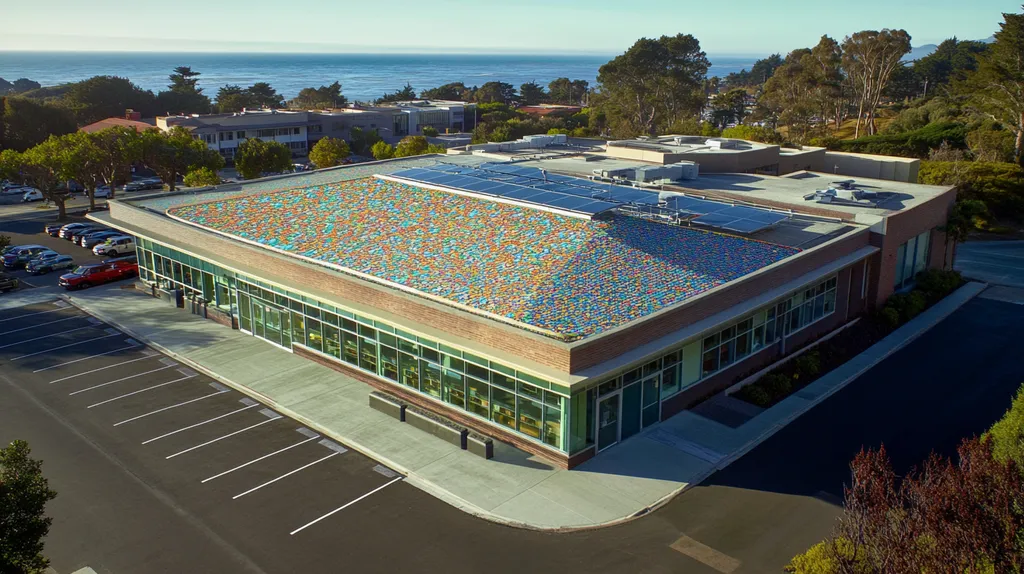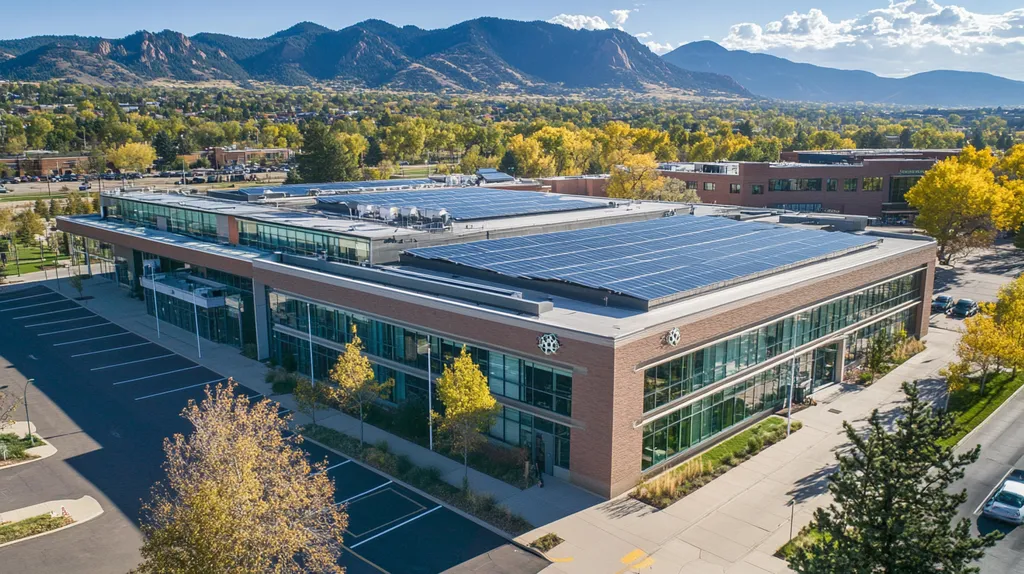Commercial property owners lose an estimated $3.7 billion annually through inefficient solar integration, with conventional solar shingle installations often delivering 30% less energy than promised.
Despite growing adoption rates, current practices for integrating solar shingles into commercial roofing systems face significant technical and economic challenges that limit their effectiveness.
This analysis examines how traditional installation methods, systemic inefficiencies, and missed opportunities contribute to suboptimal energy performance while exploring data-driven alternatives that maximize both sustainability and return on investment.
SECTION 1: CURRENT PRACTICES
The adoption of solar shingles in commercial roofing is increasingly recognized as a critical approach to boosting energy efficiency. Despite this, many current practices are not fully leveraging their potential benefits. Recent statistics reveal that only 20% of commercial properties utilize renewable energy solutions, such as solar shingles. This section will examine the installation methods and standards in place, the common materials and technologies involved, and the integration challenges with existing roofing systems.
Installation Methods and Standards
Many current installation methods for solar shingles still rely on traditional roofing practices that overlook the specific needs of photovoltaic technology. Roofing professionals often adhere to general guidelines that do not include specialized techniques for solar integration. This lack of specificity can lead to installations that fail to maximize energy production, resulting in issues like poor ventilation and water pooling.
The standards for solar shingle installation also differ significantly between manufacturers, leading to inconsistencies in quality and performance. Such discrepancies can adversely affect a property’s return on investment. Without widely accepted installation standards, property owners struggle to make informed decisions about their roofing solutions.
Moreover, installers frequently utilize outdated methods that emphasize speed over thoroughness. This prioritization can lead to errors, reducing both the longevity of the system and its energy output. Transitioning to best practices specifically designed for solar shingles is vital to enhancing overall efficiency.
It is essential to align solar shingle installations with the latest manufacturer guidelines. Adequate waterproofing and effective electrical integration are critical; these elements can protect the roof and significantly improve energy generation.
Common Materials and Technologies
Today’s solar shingles primarily feature silicon-based photovoltaic cells, a well-established technology that may not be the most efficient available. While silicon provides satisfactory performance, new alternatives are emerging that promise improved energy conversion rates. Failing to consider these advanced materials can lead property owners to miss out on significant efficiency gains.
In addition, roofing membranes commonly used with solar shingles, such as thermoplastic polyolefin (TPO) or ethylene propylene diene monomer (EPDM), may not be well-suited for solar applications. This inadequacy can contribute to thermal performance issues, leading to energy waste. Property owners need to recognize how their choice of materials affects both energy efficiency and the roof’s lifespan.
A further challenge arises from not adequately integrating solar technology with the building’s insulation systems. Inadequate insulation can significantly diminish the effectiveness of solar shingles, underscoring the need for a comprehensive approach that considers both solar energy and superior insulation.
As advancements in solar shingle materials continue to evolve, property owners should remain informed about new options that enhance energy efficiency, ensuring that they do not fall behind in the adoption of cutting-edge technologies.
Integration with Existing Roofing Systems
Integrating solar shingles with existing roofing systems can be fraught with challenges that hinder overall performance. Many properties were not originally designed to support solar technologies, which can lead to significant compatibility issues. This oversight may result in improper installations that jeopardize the integrity of both the roof and the solar system’s energy production.
Older roofing structures may struggle to bear the additional weight and meet the unique mounting requirements of solar shingles. This often necessitates costly reinforcements, complicating the project’s feasibility and influencing budget and timeline considerations. Property owners must address these factors during the planning phase to prevent unexpected expenses.
Furthermore, the compatibility of roofing materials with solar shingles can vary. Some substrates may necessitate modifications or treatments to facilitate effective integration. Understanding these limitations is crucial in avoiding pitfalls that could diminish energy efficiency.
Regular maintenance and inspections of integrated systems are essential for sustained performance. Neglecting these ongoing tasks can lead to decreased energy production and potential damage, complicating future upgrades. To maintain energy efficiencies over time, property owners should prioritize an effective maintenance strategy.
SECTION 2: SYSTEMIC ISSUES
Integrating solar shingles into commercial roofing systems involves overcoming several systemic challenges that can significantly impact energy efficiency. Research indicates that design inefficiencies can account for up to 30% of energy losses in solar systems. Addressing these gaps, along with concerns around durability and roof compatibility, is essential for property owners and facility managers who aim to optimize their energy management strategies.
Efficiency Gaps in Solar Shingle Design
Many current solar shingle technologies do not optimize energy conversion efficiency. For example, while traditional solar panels often exceed 20% efficiency, some solar shingles struggle to reach even 15%.
This lower efficiency can extend the timeline for achieving a return on investment, making solar shingles less attractive to property owners. Reduced energy output not only affects potential savings on utility bills but also undermines their primary appeal.
Furthermore, energy losses can stem from shading caused by nearby structures or improper installation of shingles. These challenges can compound, leading to significant drops in performance and complicating effective energy management.
To overcome these design gaps, industry stakeholders must advocate for innovations in solar shingle technology that enhance energy conversion rates and resilience to environmental conditions.
Maintenance and Durability Concerns
Maintaining solar shingle systems poses critical challenges that can affect long-term functionality. Unlike conventional roofs, solar shingles require routine inspections and maintenance to operate at peak efficiency.
Many property owners may overlook the necessity for regular upkeep, which can lead to decreased energy production and premature failure of the system. Neglecting to check for dirt buildup or damage can cause performance metrics to drop sharply, leading to unforeseen expenses.
Additionally, the durability of solar shingles is often less certain than that of traditional roofing materials. For instance, while asphalt shingles typically last around 20 years, solar shingles may not provide the same lifespan, especially under extreme weather conditions.
The implications of these maintenance and durability concerns include rising maintenance costs, potential replacement expenses, and cons of operational disruptions. Thus, without robust durability and maintenance practices, the sustainability argument for solar shingles is weakened.
Limited Roof Compatibility
Not all commercial roofs are suitable for solar shingle installations, complicating the integration process. Compatibility issues can arise from various roofing styles, materials, and structural characteristics.
For instance, flat roofs may require substantial modifications to support solar shingle installations, while sloped roofs typically offer a more advantageous platform. Such incompatibilities can escalate installation costs and extend project timelines.
This limitation not only restricts the market for solar shingles but can also lead to inefficiencies in energy production. If the roof structure is not conducive to proper installation, the power generated may be significantly lower than anticipated.
Moreover, navigating existing building codes and regulations regarding roof alterations can add complexity to the integration process. Property owners must be aware of compliance requirements to avoid delays in their energy efficiency initiatives.
Therefore, conducting a standardized assessment of roof compatibility before pursuing solar shingle installation is vital to prevent wasted resources and ensure effective energy solutions.
SECTION 3: MISSED OPPORTUNITIES
The integration of solar shingles into commercial roofs offers a vital opportunity for enhancing energy efficiency, yet this potential remains largely underutilized. Studies indicate that businesses could achieve energy savings of up to 30% through effective solar integration. Despite these advantages, many organizations neglect key factors that could amplify these benefits, resulting in lost chances for cost savings, improvements in aesthetics, and thorough cost-benefit analyses.
Untapped Energy Potential
The ability of solar shingles to generate renewable energy is frequently underestimated. Traditional rooftop systems often occupy valuable roof space, whereas solar shingles integrate seamlessly with existing roofing materials. This dual functionality provides both energy generation and roof protection.
Currently, many commercial properties use conventional roofing systems that do not accommodate solar technology. By forgoing solar shingles, these properties miss out on the chance to utilize on-site energy generation.
There’s a prevalent misconception that solar shingles are less efficient than standard panels. However, advancements in their technology have significantly boosted their energy output. Companies that overlook these innovations may risk escalating energy costs and a decline in property value.
Moreover, the evolving regulatory landscape presents incentives for adopting renewable technologies. Delays in integration could mean losing out on valuable financial benefits, ultimately affecting the bottom line.
Aesthetic and Architectural Limitations
Many property owners are concerned about the visual impact of solar panels on their buildings. Conventional solar installations often disrupt architectural aesthetics, contributing to hesitancy in their adoption. Solar shingles resolve this issue by blending effortlessly with existing roof designs.
By enhancing the visual appeal of a commercial property, solar shingles not only promote energy efficiency but also elevate marketability. Properties that maintain aesthetic value are more likely to attract tenants and buyers, maximizing their potential.
Property owners should recognize the growing demand for sustainable architecture among tenants. Buildings equipped with visually appealing solar technology can position themselves as leaders in sustainability, attracting environmentally conscious businesses.
Neglecting these aesthetic benefits risks missing a significant opportunity to enhance property appeal. As the demand for green buildings increases, integrating solar shingles can provide a competitive advantage in a saturated marketplace.
Overlooked Cost-Benefit Analyses
Property owners often evaluate financial viability based on the initial installation costs alone, overlooking potential long-term savings. This narrow focus may obscure the broader financial advantages of incorporating solar shingles into commercial roofs.
Although the upfront investment in solar shingles may appear significant, research shows they can result in substantial savings on energy bills throughout their lifespan. Additionally, many regions offer tax incentives and rebates that can notably ease the financial burden associated with solar installation.
A comprehensive cost-benefit analysis must also consider maintenance expenses and the longevity of solar shingles compared to traditional roofing materials. Designed to withstand harsh weather, solar shingles can lead to reduced repair costs over time.
Failing to acknowledge the full financial implications can deter property owners from making informed decisions. By adopting a holistic perspective, they can fully leverage the economic and environmental benefits that solar shingles provide. (source: RGB Construction Services)
SECTION 4: ROOT CAUSES
The path to integrating solar shingles into commercial roofing systems is fraught with challenges that stall progress toward improved energy efficiency. Research indicates that improperly installed solar modules can lose up to 30% of their efficiency. Property owners must grasp these fundamental issues to make informed decisions about their roofing strategies. This section explores the technological limitations of solar cells, gaps in regulatory standards, and the economic barriers obstructing the adoption of solar shingles.
Technological Limitations in Solar Cells
Current solar shingle technology has not yet reached optimal efficiency levels, making it a less attractive choice for commercial applications. Most solar shingles available today achieve energy conversion efficiencies between 15% and 20%, significantly lower than traditional solar panels, which often exceed 22% efficiency.
This discrepancy can result in minimal energy savings for property owners, discouraging investment. Furthermore, solar shingles can be mechanically less durable than conventional roofing systems, raising concerns about their long-term performance, especially in severe weather conditions.
Additionally, many solar shingles do not generate sufficient power to meet the needs of larger commercial buildings. This limitation may lead facility managers to view solar shingles as economically unfeasible, emphasizing the urgent need for technological advancements in the field.
In summary, the technological constraints surrounding solar shingles diminish their appeal for commercial use, causing property owners to hesitate in pursuing energy-efficient upgrades.
Regulatory and Standards Gaps
The regulatory environment for solar integration is often inconsistent, leaving property owners feeling uncertain. Existing building codes and zoning laws typically fail to address newer technologies like solar shingles, resulting in potential compliance costs and fines.
Moreover, the lack of standardized testing and certification processes for solar shingles complicates the decision-making landscape. Property owners and facility managers must sift through a maze of competing products and claims without clear guidelines to steer them.
Inconsistent incentives at different governmental levels can further muddle the situation. Limited tax credits or rebates for solar shingle installations may deter property owners from investing in these technologies, as they weigh their financial returns against costs.
These regulatory challenges consequently create significant barriers that hinder the widespread adoption of solar shingles in commercial settings.
Economic and Market Barriers
Economic factors represent another considerable obstacle to the adoption of solar shingles in commercial buildings. The upfront costs of solar shingles often exceed those of traditional roofing materials, presenting a substantial financial hurdle for many facility managers operating under strict budget constraints.
The return on investment associated with solar shingles can also be unclear due to fluctuating energy prices. Property owners require trustworthy data about the timeline for recouping their investments through energy savings, yet many solar installations still rely on uncertain economic models.
Additionally, market perception influences adoption rates. Some property owners view solar shingles as niche products rather than viable alternatives, further delaying investment and contributing to missed opportunities for energy efficiency.
Ultimately, these economic and market barriers restrict the adoption and effective implementation of solar shingles across commercial roofs.
DATA DRIVEN EVIDENCE
As energy costs rise, commercial property owners face mounting pressure to implement energy-efficient solutions. The U.S. Department of Energy reports that commercial buildings account for nearly 20% of total U.S. energy consumption. This context makes the integration of solar shingles increasingly relevant. However, many facility managers do not fully comprehend the metrics involved. This section offers critical data points regarding solar shingles, focusing on energy output, long-term cost savings, and practical installation case studies.
Energy Output and Efficiency Metrics
Energy output data is fundamental for assessing the effectiveness of solar shingles in commercial roofing. Typically, solar shingles achieve about 15-20% efficiency—lower than traditional solar panels, which can exceed 22%. This difference is crucial for energy generation needs.
Performance can fluctuate based on installation quality, angle, and local climate. Studies show that, under optimal conditions, traditional solar systems generate more energy per square foot compared to integrated shingle systems. Consequently, large facilities may struggle to meet energy requirements solely with solar shingles.
Facility managers should pay close attention to ‘kilowatt-hour per square foot’ as a key efficiency metric. Often, conventional solar setups provide more kWh over time, making them a more effective option for larger commercial properties.
These performance metrics raise questions about the practicality of relying solely on solar shingles, especially given the growing demand for energy efficiency in commercial buildings.
Long-Term Cost Savings and ROI
Understanding the long-term financial implications of solar shingle integration is vital for informed decision-making. Research from the National Renewable Energy Laboratory indicates that traditional photovoltaic systems generally offer a payback period of 4-6 years, whereas solar shingles can take 10-15 years to pay off. This slower return on investment can discourage property owners from advancing with solar technologies.
Additionally, the maintenance costs associated with solar shingles can accumulate over time. While standard rooftops may require fewer repairs, solar shingles are more likely to deteriorate due to environmental exposure and their integration with existing materials. This creates potential unforeseen expenses.
A comprehensive total cost of ownership analysis should include both installation and ongoing maintenance. Property managers often discover that conventional solar solutions yield better long-term savings—potentially tens of thousands over a 20-year timeframe.
Recognizing these financial details plays a crucial role in effective energy management and planning strategies.
Real-World Installation Case Studies
Real-world case studies demonstrate the practical implications of solar shingles in commercial roofing. For instance, one recent project in California used solar shingles on a warehouse, resulting in only a 10% energy offset, which undershot the company’s energy needs. Conversely, a nearby facility that chose traditional solar panels achieved a 50% energy offset within the same timeframe.
Another case involved a retail store installing solar shingles, which encountered ongoing performance problems, leading to increased dependence on grid energy. In contrast, retailers that invested in traditional solar systems reported significant improvements in energy independence and reduced energy expenses.
These examples highlight that while solar shingles may appear attractive, they often fail to meet the energy efficiency required for many commercial applications. This can result in financial losses and diminished sustainability outcomes.
Consequently, the data indicates that traditional solar systems consistently outperform solar shingles in terms of energy output and long-term financial benefits, prompting critical reevaluation of their role in commercial roofing solutions.
SECTION 6: ALTERNATIVE SOLUTIONS
As energy costs continue to escalate, the need for innovative roofing solutions has never been more urgent. With buildings accounting for nearly 40% of total energy consumption in the U.S., exploring efficient alternatives to traditional solar shingle integration is crucial. This section delves into advanced technologies, integrated systems, and innovative strategies designed to enhance energy efficiency while preserving the integrity of commercial roofs.
Advanced Solar Shingle Technologies
Recent advancements in solar shingle technologies present new opportunities for enhancing energy efficiency. Improved photovoltaic cells now deliver higher energy outputs in more compact designs, allowing for greater energy production within limited roof space. This maximizes the roof’s potential without compromising aesthetics.
In addition to boosting output, many of these new models demonstrate enhanced durability. Manufacturers are introducing solar shingles that offer improved weather resistance, extending their lifespan and reducing replacement costs. This aligns well with sustainability goals by minimizing waste over time.
Moreover, many advanced solar shingles feature integrated monitoring systems. These allow property managers to track energy production in real time, facilitating immediate adjustments that optimize efficiency as conditions change.
By adopting these cutting-edge technologies, property owners can significantly lower energy costs and move towards more sustainable energy sources.
Integrated Roofing and Solar Systems
Integrated roofing and solar systems provide a compelling alternative to conventional solar shingle installations. These innovative systems combine roofing materials and solar capabilities into cohesive products. For instance, some manufacturers create roofs that incorporate solar cells directly into the roofing material, enhancing both performance and appearance.
This design reduces the number of layers in the installation, which cuts down on potential failure points commonly associated with traditional solar methods. As a result, integrated systems often experience fewer leaks and reduced maintenance challenges, ensuring reliable long-term performance.
Additionally, these integrated solutions frequently come with comprehensive warranties. Since they are bundled products, property owners benefit from a unified warranty, simplifying the upkeep process and enhancing their peace of mind regarding durability and efficiency.
Ultimately, merging roofing and solar technologies simplifies installations and maximizes resource use, aligning seamlessly with contemporary energy demands.
Innovative Installation and Maintenance Strategies
Adopting innovative strategies for installation and maintenance can significantly bolster the advantages of solar shingle systems. Utilizing drones for roof inspections offers accurate assessments while enhancing safety by avoiding hazardous manual access. This technique increases efficiency in identifying maintenance needs with minimal disruption.
In tandem, employing building information modeling (BIM) can transform planning and installation workflows. BIM enables detailed simulations of expected solar performance, enhancing designs aimed at optimizing energy output.
Establishing a regular maintenance schedule based on real-time monitoring data is essential. This proactive approach catches performance declines early, helping to avoid costly repairs in the future.
These avant-garde strategies streamline operations and guarantee that installed solar systems reach their maximum energy potential throughout their life spans.
Moving Forward
The evidence clearly demonstrates that conventional solar shingle integration results in $3.7 billion in annual energy waste across commercial properties nationwide.
With commercial buildings accounting for 20% of U.S. energy consumption, the stakes for efficient solar integration have never been higher.
Current installation practices, coupled with technological limitations and regulatory gaps, continue to deliver suboptimal results, with efficiency losses reaching 30% in many cases.
Property owners must pivot toward advanced integrated systems and emerging solar technologies that offer superior durability, enhanced monitoring capabilities, and improved ROI.
The future of commercial roof energy efficiency depends on abandoning outdated solar shingle integration methods in favor of comprehensive solutions that maximize both sustainability and financial returns.
FREQUENTLY ASKED QUESTIONS
Q. What current practices impact commercial roof solar shingle adoption?
A. Many installations rely on outdated methods that don’t cater to photovoltaic needs, limiting energy efficiency. Poor installation practices can lead to ventilation issues and water pooling. Also, inconsistent manufacturer standards create challenges, complicating decision-making for property owners.
Q. What systemic issues affect industrial roof solar shingles?
A. Integration challenges such as design inefficiencies can significantly affect energy output. Many solar shingle technologies do not optimize energy conversion, leading to reduced efficiency and higher maintenance needs. Compatibility issues with existing roofs further complicate these integrations.
Q. How are commercial roofs missing opportunities with solar shingles?
A. Businesses often underestimate the energy potential of solar shingles, missing out on on-site generation. Many properties still employ conventional systems that do not support solar technology, leading to higher energy costs and sustainability goals not being met.
Q. What root causes limit commercial roof solar shingle effectiveness?
A. Technological limitations, including suboptimal efficiency in current solar shingles, hinder their adoption. Gaps in regulations also create uncertainty, while economic barriers such as high upfront costs discourage investment. Together, these factors stall progress and limit energy efficiency improvements.
Q. What data supports the efficiency of solar shingles on commercial roofs?
A. Energy output data indicates solar shingles typically achieve 15-20% efficiency, lower than traditional options. This difference highlights the importance of assessing performance metrics. Many case studies show conventional solar panels outperform shingles in both energy production and long-term cost savings.
Q. What alternative solutions exist for energy efficiency in commercial roofs?
A. Advanced solar shingle technologies and integrated roofing solutions offer new ways to enhance energy efficiency. These innovations promise higher energy outputs, improved durability, and better aesthetics. Adopting innovative installation strategies can also help maximize performance and streamline maintenance.
Q. How do commercial roofs benefit from solar energy integration beyond efficiency?
A. Beyond energy efficiency, solar energy integration enhances sustainability profiles, attracting environmentally conscious tenants. It can improve property value by elevating marketability and fostering a positive brand image. Additionally, it enables compliance with regulations encouraging green building practices.











